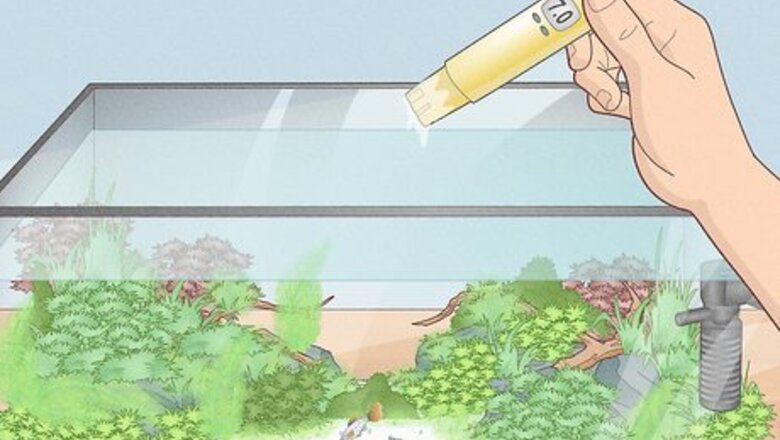
views
X
Expert Source
Doug LudemannAquarium Care Professional
Expert Interview. 27 August 2019.
But don't worry—this isn’t nearly as much work as it might seem, and with a little forethought and research, your fish will be on the road to live long and prosper!
What should the pH level be in a fish tank?
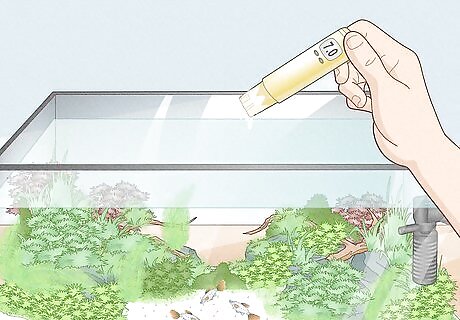
It depends on the fish, but you usually want it around 7. Most fish species can tolerate a pH of 6.5-8, and 7 is considered a “neutral” pH, so that’s normally your target. However, every species of fish thrives at a different range, so research each species in your tank to determine the level you need to maintain. If you have one species that prefers a pH of 6-7 and another species can thrive in a pH of 6.5-8, try to keep the pH between 6.5-7. If you accidentally created an environment where one species wants a pH of 6-6.5 and another species wants a pH of 8-8.5, get a second aquarium and separate them. One of those species is going to get really sick if you don’t.
How do I use a store-bought kit to test the pH in a fish tank?
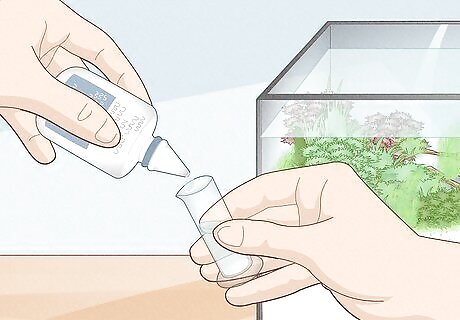
Purchase a pH testing kit and follow the instructions. There are a few different kinds of kits out there, but the two main options are the test tube kits, and the strip tests. The test tubes tend to be more accurate, but they’re both reasonable options. The strip tests are a little easier to use, but most aquarium enthusiasts find the test tube version of the test to be more accurate. There are digital meters out there as well—you just stick a probe in the water and get a reading. If you plan on testing the water regularly, these can be a good investment! They do tend to be a lot more expensive, though. A testing kit will only cost $10-20, but the accurate digital meters can be $50-100.
Scoop some water up if you have a test tube kit. Wash your hands to avoid any contaminants and scoop up a little bit of tank water in the vial that came with your kit. Pour in 3-5 drops of the testing solution per the instructions of your kit and shake the tube up. Once the water changes color, compare it to the color-coded reference chart that came with the kit to determine the pH of the water.
Put the paper directly in the water if you have a strip test. Grab one of your testing strips and stick half of it into the tank water. Slide it back and forth in the water or hold the strip steady depending on the instructions. Then, pull the strip out of the water and wait for it to start changing color. Once the color stops changing, compare the strip to the reference chart that came with your kit to find the pH. One of the benefits of these strip tests is that they often include color-coded readings for ammonia, nitrates, and other nutrients as well. However, a lot of aquarium hobbyists find these strips to be kind of unreliable.
How often should I test the pH of my tank?
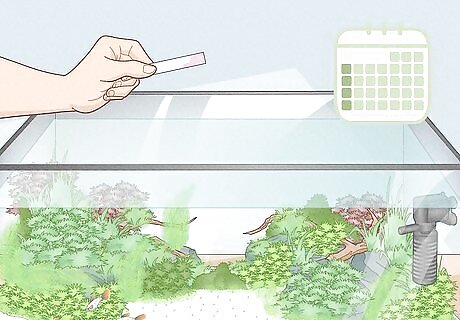
Check the pH at least once a week to keep your fish healthy. The quality of your tank’s water is directly tied to the health of your fish. A pH that is too high or low may not necessarily kill your fish, but it can stress them out, put pressure on their immune systems, and make them more susceptible to certain diseases. Keeping an eye on the pH in your tank is an important part of keeping your fish happy and healthy. Make sure that you also keep an eye on the nitrate and ammonia levels as well. The pH level isn’t the only thing you need to keep an eye on when you’re caring for fish!
How do I adjust the pH in my fish tank?
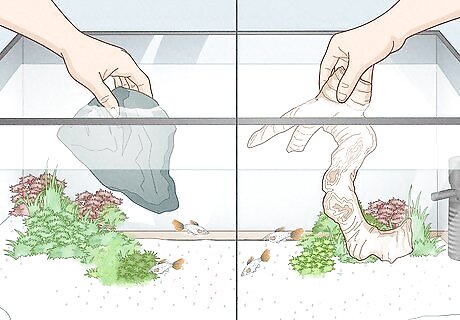
If it’s too low, change your water more often and add rocks or shells. Cycling or changing your tank’s water will reset the pH level to bring it back up to a more neutral level. You can also add aquarium-safe rocks or shells to the tank to naturally raise the pH in a stable and efficient way. You can also add 1 teaspoon (4.9 mL) of baking soda for every 5 gallons (19 L) of water to artificially raise the pH, but it can be kind of difficult to make sure you aren’t adding too much and it’s better to fix this problem by changing the water or adding things to the tank.
Try adding driftwood or peat moss to lower the pH if it’s too high. Driftwood is a particularly elegant solution since it promotes the growth of a variety of beneficial bacteria. You can also add peat moss to the tank to naturally lower the pH. You can either filter the aquarium water with peat moss before adding it to your aquarium, or use it as a substrate. There are chemicals you can buy to lower the pH artificially, but it can be exceptionally difficult to keep the pH at a stable level if you have to keep adding chemicals.
What causes pH to drop in fish tanks?

Fish waste, air, and bacteria all contribute to pull the pH down. A tank’s pH refers to the acidity or basicity of the water, and there are tons of factors that contribute to this. Over time, fish waste accumulates, and nutrients and minerals degrade. This causes the pH to drop and become more acidic. Low pH is a more common issue than a high pH. If you’re constantly running into a high pH, it’s usually because you have too many rocks or supplements in your tank.
Can I test the pH of my water without a kit?
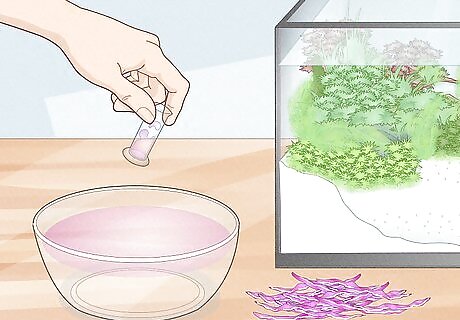
Yes, but the test is inaccurate and kind of time-consuming. Buy a red cabbage and a bottle of distilled water for this. Grate some of the cabbage and put it in a glass bowl. Then, boil 2 cups (470 mL) of distilled water. Pour the boiling water over the cabbage, stir, and wait 30 minutes. Strain the cabbage out and now you’ve got a pH testing solution! To perform the cabbage test, all you do is scoop up some of the aquarium water and pour a few drops of the cabbage juice into it. Mix the water and wait for it to change colors. The pinker the water appears, the more acidic it is, with a deep violet indicating a pH of 6. If it turns bluish, the pH is higher than 7 with a greenish color indicating a pH of 10-12.




















Comments
0 comment